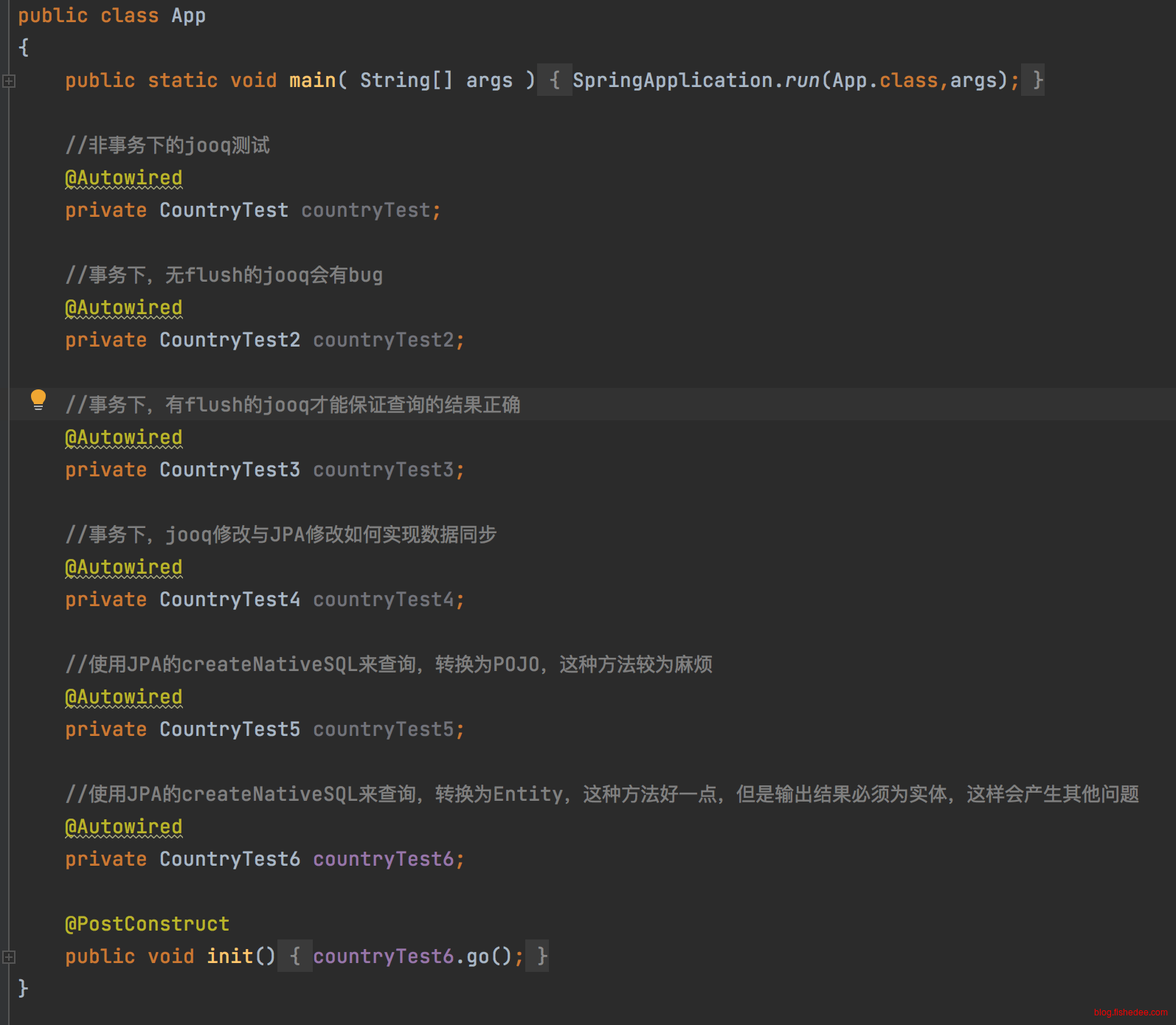0 概述
jooq经验汇总
为什么JPA的CriteriaQuery不适合做查询:
- 返回数据只能映射到实体,映射到POJO真的好麻烦,映射到实体的话又会受到一个事务中只能对应一个对象的限制。
- 只能使用JPQL这种受限的SQL语法,对于分析业务真是弱爆了
- 接口设计有问题,对比jooq可以随意链式和组合的接口,CriteriaQuery的代码很难看
Hibernate对于处理在线事务处理的业务相当在行,但是对于分析型业务,批量数据更改的业务,Hibernate的机制就会不太适合了。这种情况下,我们应该尽可能用SQL来直接表达业务,但是SQL代码属于字符串操作,在Java中开发并不顺手,另外还要考虑SQL注入的安全问题,这个时候,jooq就很合适了。
jooq的特点是:
- 优雅与灵活,尽可能以SQL的思想来表达SQL代码,同时以Java的方式表达出来
- 强类型安全性,带有代码生成工具,可以从数据库或者Entity中生成代码,以保证SQL操作的类型安全性
如果项目不大,直接全部用jooq作为ORM层也是一个不错的选择,个人认为比MyBatis更加省事
参考资料:
1 与SpringBoot整合
代码在这里
<dependency>
<groupId>org.springframework.boot</groupId>
<artifactId>spring-boot-starter-jooq</artifactId>
</dependency>
<dependency>
<groupId>org.jooq</groupId>
<artifactId>jooq-codegen</artifactId>
<scope>provided</scope>
</dependency>SpringBoot的整合相当简单
<plugin>
<groupId>org.jooq</groupId>
<artifactId>jooq-codegen-maven</artifactId>
<version>3.14.9</version>
<configuration>
<jdbc>
<driver>com.mysql.cj.jdbc.Driver</driver>
<url>jdbc:mysql://127.0.0.1:3306/library?serverTimezone=GMT%2B8</url>
<user>root</user>
<password></password>
</jdbc>
<generator>
<database>
<inputSchema>library</inputSchema>
</database>
<target>
<packageName>com.jooq_test.app.codegen</packageName>
<directory>src/main/java</directory>
</target>
</generator>
</configuration>
</plugin>在pom.xml中指定以上的配置,以上的配置为从数据库中生成代码
在Maven中,指定jooq-codegen:generate就能生成代码了
@Autowired
private DSLContext context;
@PostConstruct
public void init(){
Result<Record> result = context.select().from(Author.AUTHOR).fetch();
log.info("result {}",result);
context.insertInto(Tables.AUTHOR,Tables.AUTHOR.ID,Tables.AUTHOR.FIRST_NAME,Author.AUTHOR.LAST_NAME)
.values(1,"f1","l1")
.values(2,"f2","l2")
.execute();
Result<Record> result2 = context.select().from(Author.AUTHOR).fetch();
log.info("result2 {}",result2);
}使用jooq也很简单,直接用引用DSLContext,然后就可以了
2 与JPA整合
代码在这里
<dependency>
<groupId>org.springframework.boot</groupId>
<artifactId>spring-boot-starter-data-jpa</artifactId>
</dependency>
<dependency>
<groupId>org.springframework.boot</groupId>
<artifactId>spring-boot-starter-jooq</artifactId>
</dependency>
<dependency>
<groupId>org.jooq</groupId>
<artifactId>jooq-codegen</artifactId>
<scope>provided</scope>
</dependency>加多一个data-jpa的依赖就可以了
@Autowired
private EntityManager em;
@Autowired
private DSLContext dsl;
public void jooqTest(){
//事务状态下,要将JPA脏数据落地
if( em.isJoinedToTransaction() ){
//所有实体都落地
em.flush();
}
List<CountrySummary> countrySummaryList = dsl.select(field("name"),sum(field("man_count",Integer.class)).as("count"))
.from(table("country"))
.groupBy(field("name"))
.fetch().into(CountrySummary.class);
log.info("summary {}",countrySummaryList);
}查询之前,为了与JPA代码协同工作,需要先调用em.flush(),否则JPA的脏检查不落地,查询的数据都是旧数据。
Demo中还有JPA与jooq的不同协同方式,可以看看,避免一下坑。
3 JPA的代码自动生成
代码在这里
<plugin>
<dependencies>
<dependency>
<groupId>org.jooq</groupId>
<artifactId>jooq-meta-extensions-hibernate</artifactId>
<version>3.14.13</version>
</dependency>
<dependency>
<groupId>javax.persistence</groupId>
<artifactId>javax.persistence-api</artifactId>
<version>2.2</version>
</dependency>
</dependencies>
<groupId>org.jooq</groupId>
<artifactId>jooq-codegen-maven</artifactId>
<version>3.14.13</version>
<configuration>
<generator>
<database>
<name>org.jooq.meta.extensions.jpa.JPADatabase</name>
<properties>
<!-- A comma separated list of Java packages, that contain your entities -->
<property>
<key>packages</key>
<value>com.jooq_test.app.business</value>
</property>
<!-- Whether JPA 2.1 AttributeConverters should be auto-mapped to jOOQ Converters.
Custom <forcedType/> configurations will have a higher priority than these auto-mapped converters.
This defaults to true. -->
<property>
<key>useAttributeConverters</key>
<value>true</value>
</property>
<!-- The default schema for unqualified objects:
- public: all unqualified objects are located in the PUBLIC (upper case) schema
- none: all unqualified objects are located in the default schema (default)
This configuration can be overridden with the schema mapping feature -->
<property>
<key>unqualifiedSchema</key>
<value>none</value>
</property>
<property>
<key>hibernate.physical_naming_strategy</key>
<value>org.springframework.boot.orm.jpa.hibernate.SpringPhysicalNamingStrategy</value>
</property>
</properties>
</database>
<target>
<packageName>com.jooq_test.app.codegen</packageName>
<directory>src/main/java</directory>
</target>
</generator>
</configuration>
</plugin>更改Maven的plugin选项,改为从实体中生成代码
import static com.jooq_test.app.codegen.tables.Country.COUNTRY;
@Autowired
private EntityManager em;
@Autowired
private DSLContext dsl;
public void jooqTest(){
//事务状态下,要将JPA脏数据落地
if( em.isJoinedToTransaction() ){
//所有实体都落地
em.flush();
}
List<CountrySummary> countrySummaryList = dsl.select(COUNTRY.NAME,sum(field(COUNTRY.MAN_COUNT)).as("count"))
.from(COUNTRY)
.groupBy(COUNTRY.NAME)
.fetch().into(CountrySummary.class);
log.info("summary {}",countrySummaryList);
}这个时候,查询就能可以以引入类的方式查询,有强类型的支持了
4 自由拼接sql
代码在这里
4.1 实体
package com.jooq_test.app.business;
import lombok.Getter;
import lombok.ToString;
import javax.persistence.Entity;
import javax.persistence.GeneratedValue;
import javax.persistence.GenerationType;
import javax.persistence.Id;
@Entity
@ToString
@Getter
public class Country {
private static Long globalId = 10001L;
@Id
private Long id;
private String name;
private Integer manCount;
protected Country(){
}
public Country(String name,Integer manCount){
this.id = globalId++;
this.name = name;
this.manCount = manCount;
}
public void modName(String name){
this.name = name;
}
public void modCount(int count){
this.manCount = count;
}
}Country实体
package com.jooq_test.app.business;
import lombok.Getter;
import lombok.ToString;
import org.springframework.stereotype.Component;
import org.springframework.web.bind.annotation.GetMapping;
import javax.persistence.Entity;
import javax.persistence.Id;
@Entity
@ToString
@Getter
public class People {
private static Long globalId = 10001L;
@Id
private Long id;
private String name;
private Long countryId;
protected People(){
}
public People(String name,Long countryId){
this.id = globalId++;
this.name = name;
this.countryId = countryId;
}
}People实体
package com.jooq_test.app;
import com.jooq_test.app.business.Country;
import com.jooq_test.app.business.CountryRepository;
import com.jooq_test.app.business.People;
import com.jooq_test.app.business.PeopleRepository;
import lombok.AllArgsConstructor;
import lombok.Data;
import lombok.NoArgsConstructor;
import lombok.extern.slf4j.Slf4j;
import org.jooq.DSLContext;
import org.springframework.aop.framework.AopContext;
import org.springframework.beans.factory.annotation.Autowired;
import org.springframework.stereotype.Component;
import javax.transaction.Transactional;
import java.util.List;
import static org.jooq.impl.DSL.*;
@Component
@Slf4j
public class CountryTest {
@Autowired
private CountryRepository countryRepository;
@Autowired
private PeopleRepository peopleRepository;
@Transactional
public void initData(){
countryRepository.add(new Country("CHINA",100));
countryRepository.add(new Country("US",10));
countryRepository.add(new Country("JAPAN",10));
peopleRepository.add( new People("CHINA_1",10001L));
peopleRepository.add( new People("CHINA_2",10001L));
peopleRepository.add( new People("US_1",10002L));
peopleRepository.add( new People("US_2",10002L));
peopleRepository.add( new People("JAPAN_1",10003L));
peopleRepository.add( new People("JAPAN_2",10003L));
}
@Transactional
public void clearAll(){
List<Country> countryList = this.countryRepository.getAll();
for( Country country : countryList){
this.countryRepository.del(country);
}
List<People> peopleList = this.peopleRepository.getAll();
for( People people : peopleList){
this.peopleRepository.del(people);
}
}
public void showAll(){
List<Country> countryList = this.countryRepository.getAll();
log.info("{}",countryList);
List<People> peopleList = this.peopleRepository.getAll();
log.info("{}",peopleList);
}
public void go(){
CountryTest app = (CountryTest) AopContext.currentProxy();
app.clearAll();
app.initData();
app.showAll();
}
}注入初始数据,没啥好说的
4.2 工具
package com.jooq_test.app;
import org.jooq.DSLContext;
import org.jooq.Query;
import org.jooq.ResultQuery;
import org.springframework.beans.factory.annotation.Autowired;
import org.springframework.stereotype.Component;
import javax.persistence.EntityManager;
import java.util.List;
import static org.jooq.impl.DSL.*;
@Component
public class JooqRepository {
@FunctionalInterface
public interface JooqFetcher{
ResultQuery apply(DSLContext dsl);
}
@Autowired
private EntityManager em;
@Autowired
private DSLContext dslContext;
public <T> List<T> fetch(JooqFetcher fetcher,Class<T> clazz){
if( em.isJoinedToTransaction()){
//将所有实体刷新到数据库中
em.flush();
}
ResultQuery query = fetcher.apply(this.dslContext);
return query.fetchInto(clazz);
}
}创建一个JooqRepository,也没啥好说的
4.3 按需查询与聚合
package com.jooq_test.app;
import lombok.AllArgsConstructor;
import lombok.Data;
import lombok.NoArgsConstructor;
import org.jooq.*;
import org.springframework.beans.factory.annotation.Autowired;
import org.springframework.stereotype.Component;
import java.math.BigDecimal;
import java.util.ArrayList;
import java.util.Date;
import java.util.List;
import static org.jooq.impl.DSL.*;
@Component
public class QueryTest {
@Data
@AllArgsConstructor
@NoArgsConstructor
public static class DTO{
private Long id;
private String name;
}
@Data
@AllArgsConstructor
@NoArgsConstructor
public static class Filter{
private String countryName;
private String peopleName;
private Integer pageIndex;
private Integer pageSize;
}
@Autowired
private JooqRepository jooqRepository;
public List<DTO> get(Filter filter){
return jooqRepository.fetch((jooq)->{
SelectSelectStep<?> selectStep = jooq.select(field("country.name").as("name"),field("country.id").as("id"));
//按需join
SelectJoinStep<?> joinStep;
if( filter.peopleName != null ){
joinStep = selectStep.from(table("country").innerJoin(table("people")).on("country.id = people.country_id"));
}else{
joinStep = selectStep.from(table("country"));
}
//按需where
List<Condition> condition = new ArrayList<>();
if( filter.countryName != null ){
condition.add(field("country.name").equal(filter.countryName));
}
if(filter.peopleName != null ){
condition.add(field("people.name").equal(filter.peopleName));
}
SelectGroupByStep<?> conditionStep;
if( condition.size() != 0 ){
conditionStep = joinStep.where(condition);
}else{
conditionStep = joinStep;
}
//按需分页
if( filter.pageIndex != null && filter.pageSize != null ){
return conditionStep.limit(filter.pageSize).offset(filter.pageIndex);
}else{
return conditionStep;
}
},DTO.class);
}
@Data
@AllArgsConstructor
@NoArgsConstructor
public static class DTO2{
private Long countryId;
private Long sum_id;
private Integer count;
}
public List<DTO2> group(){
return jooqRepository.fetch((jooq)->{
return jooq.select(count().as("count"),sum(field("id",Integer.class)).as("sum_id"),field("country_id"))
.from("people")
.groupBy(field("country_id"));
},DTO2.class);
}
}这是自由拼接sql的方式,好处在于直接映射到sql,也没有sql注入的问题,缺点就是丢失强类型特性了。
4.4 测试代码
package com.jooq_test.app;
import lombok.extern.slf4j.Slf4j;
import org.jooq.*;
import org.jooq.impl.DSL;
import org.springframework.beans.factory.annotation.Autowired;
import org.springframework.boot.SpringApplication;
import org.springframework.boot.autoconfigure.SpringBootApplication;
import org.springframework.context.annotation.EnableAspectJAutoProxy;
import org.springframework.transaction.annotation.EnableTransactionManagement;
import javax.annotation.PostConstruct;
import java.util.List;
/**
* Hello world!
*
*/
@SpringBootApplication
@EnableTransactionManagement(proxyTargetClass = true)
@EnableAspectJAutoProxy(exposeProxy = true)
@Slf4j
public class App
{
public static void main( String[] args )
{
SpringApplication.run(App.class,args);
}
//非事务下的jooq测试
@Autowired
private CountryTest countryTest;
@Autowired
private QueryTest queryTest;
@PostConstruct
public void init(){
countryTest.go();
//普通query测试
QueryTest.Filter filter = new QueryTest.Filter();
filter.setPageIndex(0);
filter.setPageSize(10);
filter.setCountryName("CHINA");
List<QueryTest.DTO> result = queryTest.get(filter);
log.info("query1 {}",result);
//join测试
QueryTest.Filter filter2 = new QueryTest.Filter();
filter2.setPeopleName("US_2");
List<QueryTest.DTO> result2 = queryTest.get(filter2);
log.info("query2 {}",result2);
//group测试
List<QueryTest.DTO2> result3 = queryTest.group();
log.info("group {}",result3);
}
}测试代码也比较简单
5 总结
对于与JPA整合的jooq项目,我建议是:
- 不需要使用类型安全性,因为总是需要在编译前点多一下,没有必要。
- 绕开JPA的nativeQuery查询,直接用flush + jooq的fetch操作就可以了。JPA的nativeQuery的设计真是一言难尽,难以转换为POJO,转换为实体又会带来以外的问题。
- JOOQ不要做修改操作,只做查询操作。JOOQ做修改操作的时候,会与JPA的脏检查机制有冲突。
JOOQ相比MyBatis的优势在于:
- 更容易支持按需join,按需where,按需limit
- 支持获取JPA实体
- 本文作者: fishedee
- 版权声明: 本博客所有文章均采用 CC BY-NC-SA 3.0 CN 许可协议,转载必须注明出处!

